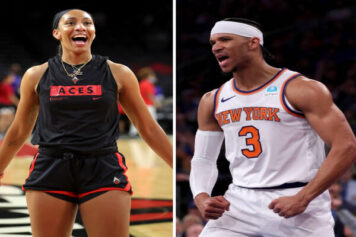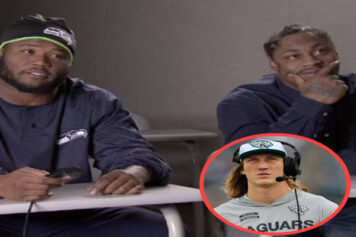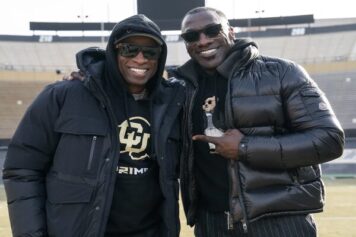N.W.A arent just pioneers in hip-hop music.
They are also trendsetters in urban style.
Just as they had an impact on a musical genre that was initially dismissed, many of the sports teams in America owe them a finders fee for introducing them to lucrative world of urban culture.
Im 36 years old. I grew up in the era when people were getting robbed and shot over team paraphernalia, particularly Starter jackets. Having a Starter jacket in my household was a polarizing thing due to the repercussions it could bring. Because of N.W.A, I wanted a Raiders jacket and a White Sox cap so I asked my mom to buy a Raiders Chalk Line jacket for me. It wasnt a Starter jacket but it did the trick. Next thing I knew, dad told me to take it back to the store because he didnt want me to get shot over it. This was the era when most of our parents had a hard time understanding rap music; think of the father in LL Cool J’s “I Need Love” video tearing down his daughter’s LL poster.
A few years later my dad finally relented and allowed me to buy a Chicago Bears Starter jacket. When I first put it on I believed that I finally had made it. A couple of weeks later, I found out that my newly elevated social status was going to be short lived. A kid in another class at my school had the same jacket I did and had it snatched, complete with a beat down. Concerned for my own safety, as I took the bus to school just like he did, I didnt wear my jacket until the heat cooled off. Imagine the irony of me spending so much time fighting over the right to have a Starter jacket and then having to stop wearing my symbol of pride and statue out of fear.
Sports apparel is traditionally worn by fans. In the 80’s and 90’s, many rappers showed their hometown pride by wearing local team gear, a practice duplicated by people in urban areas, and later in the suburbs, who identified with the rappers and the culture. With the popularity of N.W.A., demand for Raiders gear skyrocketed, so much so that the Chicago White Sox and the Los Angeles Kings changed their team colors to black, sliver and white.
Almost overnight, the hood responded and the team gear flew off the racks. Flash forward to present day and the movie Straight Outta Compton featured a Chicago White Sox in the opening scene, even though the team hadnt started wearing that cap until the 1991 season.
Teams like the White Sox wanted to (indirectly) capitalize off of N.W.A.’s success, which they did, leading to one the reasons USA Todays For The Win named the White Sox cap No.2 on their 2014 list of the 10 best caps in Major League Baseball. The team has openly embraced their gear being featured prominently in a film that has broken box offices number in a short period of time, now the highest grossing music biopic in history with $134 million in ticket sales.
When the White Sox introduced our new logo and color scheme, the popular black and white look immediately enjoyed cross-cultural appeal, Scott Reifert, the clubs senior vice president of communications, told the Chicago Tribune. As such, it has long been popular among all of our fans, including the hip-hop community that stretches back to the early days of NWA, Dr. Dre, Ice Cube and Eazy-E. That trend continues today with young artists like Chance the Rapper and Kendrick Lamar. Without having seen the movie, we cant speak to the specifics. However, the White Sox black cap and logo, as seen in the movie trailer, was introduced in September 1990 by the organization and anecdotally, we understand that the White Sox logo was part of the groups look throughout their successful music careers.
The aforementioned teams made money off of the exposure but some of the teams were unknowingly dragged into gang conflicts. Many of those were detailed in the Ice Cube produced “30 for 30” documentary on ESPN entitled Straight Outta L.A. In the documentary Ice Cube explained the impact the Raiders, and their gear, had on Los Angeles inner city:
That team represented the L.A. I knew, Cube explained in the documentary. It wasnt the Showtime Lakers, where people saw the glitz and the glamour. It wasnt the 84 Olympics. It was a little more grimey, and the Raiders represented that, in South Central [where they played]. They had the whole city on lock. To me, [this project] is the true representation of music and sports.
**
In urban culture, your gear can represent your being and incite reaction. And it’s not just about blue and red.
When I went to the east coast for college, I made sure I had some Bears, Bulls, Cubs and White Sox gear. I wanted people to know that I repped Chicago but sometimes that type of statement would get some folks riled up. Many of the rappers I loved growing up, and still to this day, wore some type of team apparel; they wanted to be sure that everyone knew where they were coming from. It was humble, yet demonstrative, bragging and more often that not, that type of swagger breeds contempt.
Yes, haters were gonna hate.
That’s why so many kids were getting robbed and shot over team apparel. Check out this stanza from a 1993 Baltimore Sun article:
On New Year’s Eve, during a visit with her father Karla M. Benner, 17, of Baltimore, was fatally shot six times in Youngstown, Ohio, when three men demanded her Georgia Bulldogs jacket. She was shot while taking off her jacket, authorities said.
Damien, like other young people, said he likes the jacket because “it’s the style.”
Ryan Cesaitis, 14, owns a $109.99 red, white and blue Washington Capitals Starter jacket. “If [someone] threatened me with a gun, I’d give it up right away,” he said.
The Glenelg Country School student said he believes the violence — sometimes associated with “the jacket everybody is wearing” — is isolated. “I’ve had it for over a year, and no one has bothered me,” he said.
Starter jackets, which feature names of professional and collegiate sporting teams and their colorful mascots, sell from $69 to $300, retailers said.
At Marvin’s Sports City in the Columbia Mall, assistant manager Brian Hodges said the popular jackets generated 30 percent to 40 percent of the store’s Christmas sales.
With the negativity surrounding urban lifestyles and fashion, teams are very apprehensive of players who grew up idolizing this lifestyle and groups like N.W.A. That may have been the underlying reason why the Eagles got rid of DeSean Jackson. According to NJ.com, the Eagles were worried about Jacksons alleged ties an L.A. street gang, which was connected to two homicides. Apparently, seeing photos of Jackson wearing clothes associated with gang members was all the Eagles needed.
Here a part of a statement Jackson released after the Eagles let him go:
I would like to address the misleading and unfounded reports that my release has anything to do with any affiliation that has been speculated surrounding the company I keep off of the field. I would like to make it very clear that I am not and never have been part of any gang. I am not a gang member and to speculate and assume that I am involved in such activity off the field is reckless and irresponsible. I work very hard on and off the field and I am a good person with good values. I am proud of the accomplishments that I have made both on and off the field. I have worked tirelessly to give back to my community and have a positive impact on those in need. It is unfortunate that I now have to defend myself and my intentions. These reports are irresponsible and just not true.
Once everything was said and done, the Eagles might have been looking for anything that stuck in order to get rid of Jackson. Remember when a photo floated around of a Missouri Highway Patrol officer during the Ferguson unrest? Conservative websites thought the officer was a gang member but in actuality he was in a fraternity. Sometimes thats all someone needs. A symbol to incite fear and rally around, like a black jacket with a pro team’s logo on it.
When a lie is told enough times, it becomes the truth.
With “Straight Outta Compton” now just shy of $150 million and the biggest music biopic of all time, there is no doubting the influence of hip-hop culture and music and someone will always be there to cash in. In most cases, they wont want to know how the sausage is made but they’re more than happy to eat it.
But with all of the money coming in, they’ll rejoice in the words of Dr. Dre as they roll in the dough while continuing to witness the strength of street knowledge.





